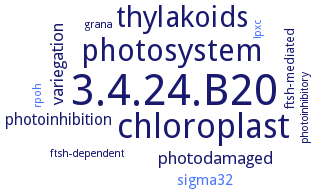3.4.24.B20: FtsH protease
This is an abbreviated version!
For detailed information about FtsH protease, go to the full flat file.

Word Map on EC 3.4.24.B20 
-
3.4.24.B20
-
chloroplast
-
photosystem
-
thylakoids
-
variegation
-
photodamaged
-
photoinhibition
-
sigma32
-
ftsh-mediated
-
rpoh
-
grana
-
lpxc
-
photoinhibitory
-
ftsh-dependent
- 3.4.24.B20
- chloroplast
-
photosystem
- thylakoids
-
variegation
-
photodamaged
-
photoinhibition
- sigma32
-
ftsh-mediated
- rpoh
-
grana
- lpxc
-
photoinhibitory
-
ftsh-dependent
Reaction
degradative cleavage of proteins =
Synonyms
AAA protease, AtFtsH, AtFtsH2, AtFtsH5, AtFtsH6, ATP-dependent zinc metalloprotease, filamentation temperature sensitive H, filamentation temperature sensitive H protease, FtsH, FtsH (slr0228), FtsH metalloprotease, FtsH protease, FtsH protease slr0228, FtsH1, FtsH10, FtsH11, FtsH12, FtsH2, FtsH2 protease, FtsH3, FtsH4, FtsH5, FtsH6, FtsH7, FtsH8, FtsH9, FTSHA, FtsHB, HflB, M41.005, More, putative cell division protein, RISP-degrading activity, slr0228, VAR1, VAR2, zinc dependent protease, ZmFtsH2A, ZmFtsH2B
ECTree
Advanced search results
Crystallization
Crystallization on EC 3.4.24.B20 - FtsH protease
Please wait a moment until all data is loaded. This message will disappear when all data is loaded.
structures of a transmembrane helix-lacking FtsH construct from Aquifex aeolicus, at 2.9 A and 3.3 A resolution in space groups R32 and P312, respectively. In both structures, the FtsH hexamer is created from two different subunits of the asymmetric unit by the threefold symmetry of the crystals. All subunits are loaded with ADP. Within the ATPase cycle while the whole subunit switches from the opened to the closed state, pore loop-1 interacts with the substrate and translocates it into the proteolytic chamber
vapor diffusion method, using either 2 M ammonium sulfate, 0.1 M Tris-HCl pH 8.5, 10 mM EDTA or, as another condition, 60% tacsimate pH 7.0, 10 mM adenylyl imidodiphosphate lithium salt hydrate
cytosolic region of apo-FtsH, microbatch method by mixing equal volumes of 20 mg/ml protein with crystallization buffer containing 30% w/v PEG 400, 200 mM CaCl2, 100 mM HEPES, pH 7.5, 200 mM glycine, and 0.1-0.2% w/v low-melt agarose, 20°C, X-ray diffraction structure determination and analysis at 2.6 A resolution


 results (
results ( results (
results ( top
top





